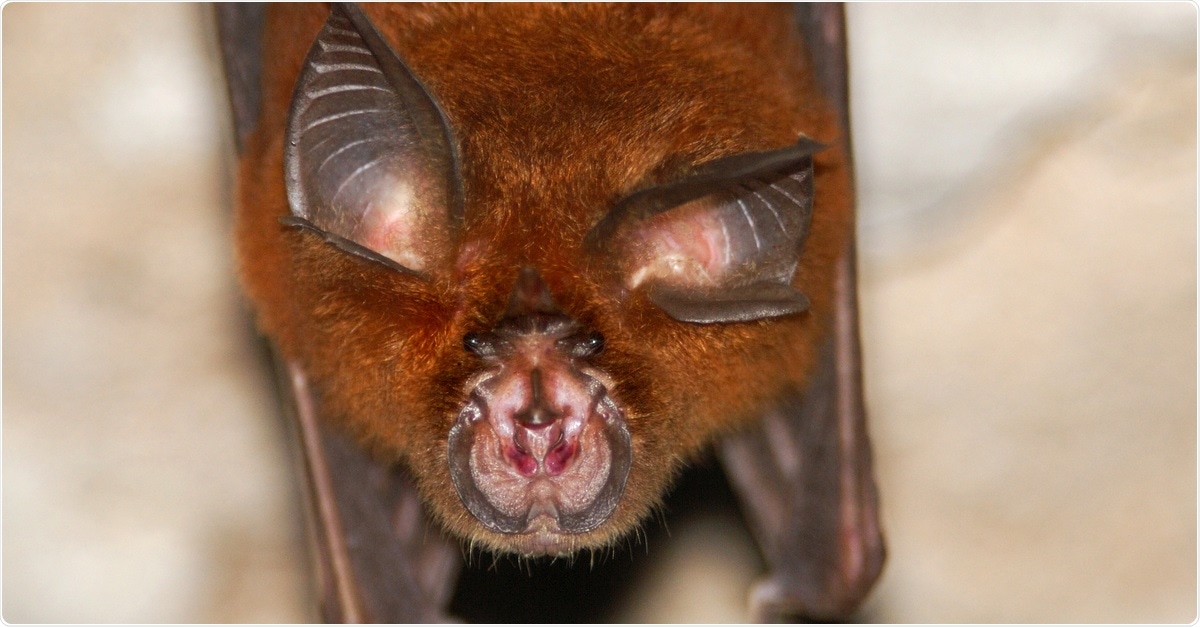Severe acute respiratory syndrome coronavirus 2 (SARS-CoV-2), the pathogen responsible for the coronavirus disease 2019 (COVID-19) pandemic, is believed to have originated in Wuhan, China, from a zoonotic origin.

A closely related novel coronavirus to SARS-CoV-2 has been found in two horseshoe bats captured and frozen in Cambodia in 2010 for scientific research. Image Credit: Hugh Lansdown / Shutterstock
Zoonosis occurs when a virus originating in animals is able to jump to, and transmit between, human hosts. SARS-CoV-2 is a betacoronavirus, in the same family as SARS-CoV and MERS-CoV, which are animal-derived pathogens characterized by their lipid envelope, positive-strand RNA genome and the crown-like spike proteins from which they derive their name.
These spike proteins (or S proteins) allow the virus to attach itself to the angiotensin-converting enzyme 2 (ACE2) receptor of host cells. After binding to the ACE2 receptor, the virus instigates membrane fusion, hijacks the cell’s metabolic processes and commences viral replication.
The ACE2 receptor is abundantly expressed in the human epithelial cell tissue that lines the respiratory and intestinal tracts; it is by this means that the virus is primarily respiratory and has been able to infect humans, typically finding its way to the lungs through the mouth, nose or eyes.
Virologists have so far traced SARS-CoV-2’s origin back to a horseshoe bat species (these being a common reservoir of novel coronaviruses). The virus is then thought to have jumped to humans via an as yet unknown intermediary host at a ‘wet market’ in Wuhan, China. Pangolins, widely sold and consumed in the region, were initially thought to have been the intermediary hosts. However, recent research has suggested that this might not be the case; an intermediary host is yet to be verified.
In a major new discovery that might deepen our understanding of SARS-CoV-2’s animal origins and its genetic evolution, a coronavirus very closely related to SARS-CoV-2 has been discovered in two horseshoe bats outside of China.
What? Where? When? And how?
A very similar coronavirus pathogen to SARS-CoV-2 has been detected in two Shamel’s horseshoe bats (Rhinolophus shameli) in Cambodia. The bats were captured in northern Cambodia in 2010 and frozen as samples for scientific research.
Dr. Veasna Duong, a virologist at the Pasteur Institute in Cambodia, led a team of international researchers to search through old samples in Cambodia to hunt for close genetic relatives to SARS-CoV-2. They had announced this discovery earlier this month (November 2020).
What does this mean for our understanding of SARS-CoV-2?
Scientists are still sequencing the viral genome to gain a better sense of its exact phylogeny as well as its relation to SARS-CoV-2. To provide such insights, the virus would have to share more than 97% of its genome with SARS-CoV-2. This would be more than its closest currently known relative, say the researchers.
What this means for our understanding of the pandemic, then, is yet to be borne out. But even if the pathogen proves to be less closely related than anticipated, it may still be useful in helping scientists learn more about the diversity of this betacoronavirus family.
What we do know so far is that this groundbreaking finding, together with an earlier discovery in a Japanese bat of a more distant relative of SARS-CoV-2 in 2013, confirms that Rhinolophus bats are the reservoirs of these viruses.
The real significance of Dr. Duong and their team’s discovery will shortly be unraveled as more of the details of these coronaviruses are determined.
The ongoing crisis
To date, over 60 million people have been infected with SARS-CoV-2 across 191 countries and territories, and over 1.41 million have died.
As the Northern Hemisphere enters colder months – a climate that favors SARS-CoV-2 transmission – a series of ‘second waves’ have been reported. Many parts of Europe – including Italy, Belgium and the United Kingdom – have reinstated nationwide lockdowns in an attempt to curb the virus’s spread.
While major advances have occurred over the last few months in terms of promising vaccine candidates, no targeted, safe and effective antiviral or prophylactic treatment has been developed and rolled out to combat SARS-CoV-2. Non-pharmaceutical interventions (NPIs) like social distancing, regular handwashing and mask-wearing in public remain the most effective measures to limit the spread of the virus.
Source:
Journal reference: